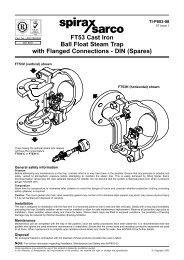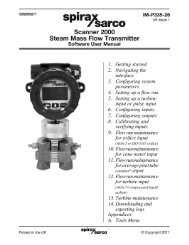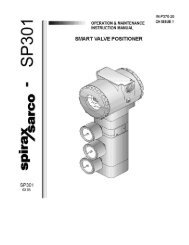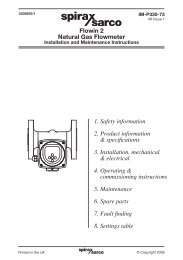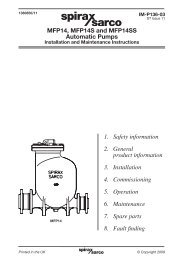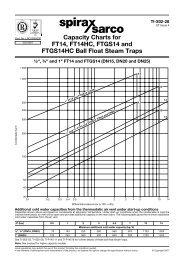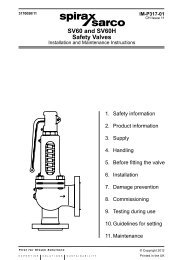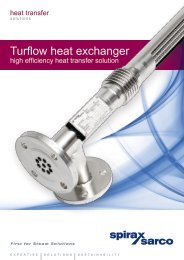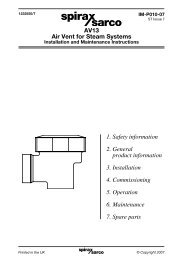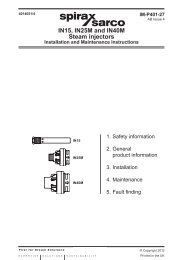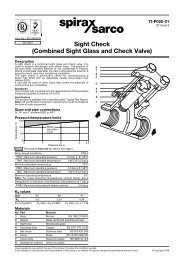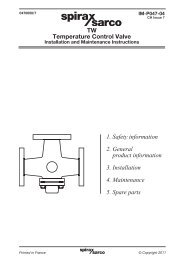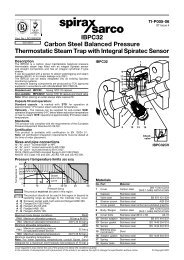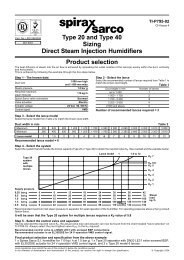Scanner 2000 Steam Mass Flow Transmitter ... - Spirax Sarco
Scanner 2000 Steam Mass Flow Transmitter ... - Spirax Sarco
Scanner 2000 Steam Mass Flow Transmitter ... - Spirax Sarco
Create successful ePaper yourself
Turn your PDF publications into a flip-book with our unique Google optimized e-Paper software.
<strong>Scanner</strong> ® <strong>2000</strong> microEFM Section 5<br />
Section 5—<strong>Scanner</strong> <strong>2000</strong> Maintenance<br />
The <strong>Scanner</strong> <strong>2000</strong> is engineered to provide years of dependable service with minimal maintenance. Batteries<br />
require periodic replacement, and battery life depends on whether battery power is the primary or secondary<br />
power source, the configuration settings of the <strong>Scanner</strong> <strong>2000</strong>, and ambient temperature conditions.<br />
All configuration settings are stored in nonvolatile memory; therefore, configuration settings will not be lost<br />
in the event of battery failure.<br />
The circuit assembly or keypad may also require replacement over the life of the instrument. Replacement<br />
procedures are provided in this section.<br />
!<br />
WARNING: Before servicing the <strong>Scanner</strong> <strong>2000</strong>, disconnect all power sources/signal sources or<br />
verify that the atmosphere is free of hazardous gases.<br />
Lithium Battery Pack Replacement<br />
The <strong>Scanner</strong> <strong>2000</strong> uses a lithium battery pack with a typical life expectancy of 1 year. Due to the flat discharge<br />
characteristics of the lithium battery, it is difficult to determine how much life remains in a battery at any given<br />
time. To preserve configuration and accumulated volume data, replace the battery pack at 1-year intervals.<br />
!<br />
!<br />
WARNING: To prevent ignition of hazardous atmospheres, do not remove the cover while circuits<br />
are alive. The <strong>Scanner</strong> <strong>2000</strong> poses no hazard when opened in a safe area.<br />
WARNING: The lithium battery pack that powers the <strong>Scanner</strong> <strong>2000</strong> is a sealed unit; however,<br />
should a lithium battery develop a leak, toxic fumes could escape upon opening the enclosure.<br />
Ensure that the instrument is in a well-ventilated area before opening the enclosure to avoid<br />
breathing fumes trapped inside the enclosure. Exercise caution in handling and disposing of<br />
spent or damaged battery packs. See additional information in Appendix B—Lithium Battery<br />
Information.<br />
Important Press the ENTER/SAVE key on the keypad before replacing the lithium battery pack to<br />
save accumulated grand totals and previous day totals for flow run and turbine volume,<br />
energy, and mass to nonvolatile memory. Once the battery pack is replaced and power is<br />
restored to the unit, the last saved accumulated totals will be displayed in the LCD. The<br />
instrument clock will need to be reset following battery replacement. All configuration<br />
and calibration settings are automatically saved to non-volatile memory and are not affected<br />
by a temporary loss of battery power.<br />
The lithium battery pack is secured inside the enclosure by a velcro strap and connected to a connector (J1)<br />
near the top of the circuit assembly.<br />
To replace a lithium battery pack in the <strong>Scanner</strong> <strong>2000</strong>, perform the following steps:<br />
1. Unscrew the cover of the enclosure counter-clockwise until it separates from the main body of the enclosure.<br />
2. Using a small standard blade screwdriver, remove the two #4-40 × 7/8” screws located to the right and<br />
left side of the display (Figure 5.1, page 76).<br />
75



